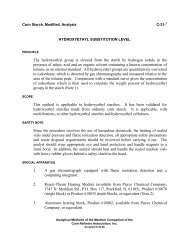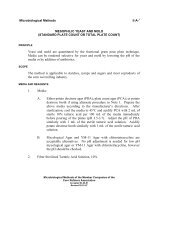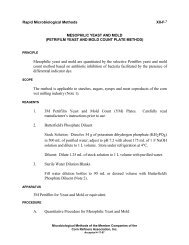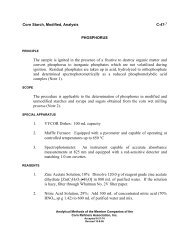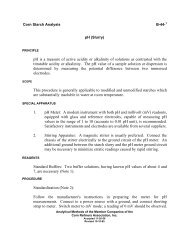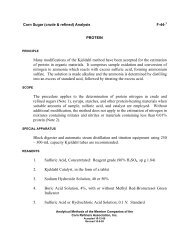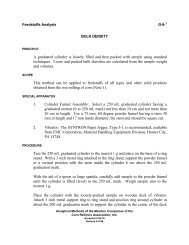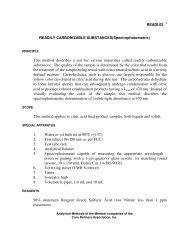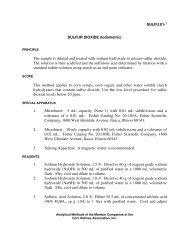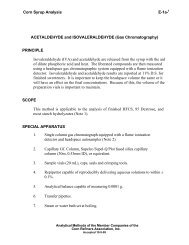Corn
2007 Corn Annual - Corn Refiners Association
2007 Corn Annual - Corn Refiners Association
- No tags were found...
Create successful ePaper yourself
Turn your PDF publications into a flip-book with our unique Google optimized e-Paper software.
The Year in ReviewAudrae EricksonPresident<strong>Corn</strong> Refiners AssociationThe United States is the largest cornproducer in the world. This year, U.S.corn farmers maintained their distinctionas the most abundant and reliable globalsupplier of corn by producing the largest cropon record ever.<strong>Corn</strong> grown on American soil benefitsconsumers throughout the world in a variety ofways—from the golden kernels used to feedanimals to the corn starch used in bindingpharmaceuticals. Products from the cornrefining industry touch human lives all overthe globe by making thousands of foods,personal and health care items, home productsand industrial goods possible.2007 <strong>Corn</strong> AnnualThis year’s <strong>Corn</strong> Annual provides a glimpse ofthe importance of American corn to the globaleconomy. Our featured guest author is wellknown to the corn refining industry and arespected veteran of agricultural policy andpromotion. U.S. Department of Agriculture(USDA) Acting Secretary Charles F. Connershares his thoughts on the impact of exportmarkets for U.S. corn as they relate to price,availability and policy.<strong>Corn</strong> Refiners Association Chairman James P.Zallie of National Starch and ChemicalCompany analyzes the patterns of exports ofrefined corn products over the past twentyyears to provide insight into potential areas formarket developments in the coming years.Sakharam K. Patil, Ph.D., draws on his 30years of experience in the industry to discussthe impact of technological advancements inrefined corn products to help meet the needs ofan expanding global population.Issues of Importance to the IndustryObesityThe national debate on obesity involves animportant health concern facing our nation andraises issues that deserve well-founded,science-based responses. Unfortunately, themedia cover the subject of obesity withvarying levels of expertise and depth that attimes oversimplify the issue by attempting tosingle out specific food ingredients, includinghigh fructose corn syrup (HFCS), as the soleor predominant cause of this multi-facetedsocietal problem.The CRA employs a number of strategies tocorrect the record by providing science-basedfacts about HFCS. CRA’s rapid responsesystem for communicating with journalists andmedia outlets that mischaracterize HFCS hasbeen effective in educating both the media andthe public. Reports that provide inaccurateHFCS information appear to be declining, andwe have begun seeing articles that defendHFCS as a safe and useful ingredient,consistent with the Food and DrugAdministration’s “Generally Recognized asSafe” or “GRAS” determination that wasinitially granted to HFCS in 1983.Several studies published in peer-reviewedjournals in 2007 have added further scientificsupport for our efforts to demonstrate thesafety and value of HFCS. The February 2007issue of Nutrition, for example, includes astudy by Kathleen J. Melanson, et al. on theeffects of HFCS and sucrose on circulatinglevels of glucose, leptin, insulin and ghrelin.The study found no differences in themetabolic effects of HFCS and sucrose.Similarly, Pablo Monsivais and colleagues atthe University of Washington demonstrate thatbeverages sweetened with sucrose, HFCS andaspartame all have similar effects on satiety(feeling of fullness) in a study published in theJuly 2007 issue of the American Journal ofClinical Nutrition. The August 2007 issue ofCritical Reviews in Food Science andNutrition includes an expert review on HFCSand weight gain led by Richard Forshee,Ph.D., of the University of Maryland Centerfor Food, Nutrition, and Agriculture Policy.These experts found insufficient support forthe notion that HFCS could play a uniquecausal role in obesity. The August 2007 issueof Food and Chemical Toxicology includes astudy by Sam Sun and Mark Empieconcluding that those who frequently consumesweetened soft drinks do not have a higherobesity rate than those who rarely drink them.Proactive communication with dieticians,other health professionals and the journalistswho cover this field is another component ofCRA’s engagement in the obesity debate. The2 | 2007 <strong>Corn</strong> Annual



